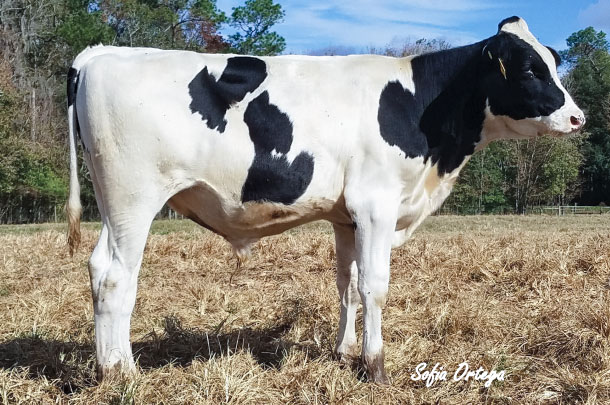Thanks to researchers at the University of Florida, it is now possible to breed a Holstein that can better withstand heat stress.
Genetics may be a new tool for decreasing the summer slump of milk production and reproduction. Dr. Peter Hansen says two bulls are now commercially available that possess a haplotype for a shorter, sleeker hair coat, known as “slick.”
“We’ve got data that suggests slick-haired Holsteins are better at regulating body temperature,” Hansen says. “There’s also data that milk drops less during the summer.”
According to Hansen, even when cooled with fans and sprinklers, cows in Florida typically drop 10 to 15 percent in milk production and as much as 20 to 25 percent in fertility during the hottest times of the year.
“We think using the slick mutation will allow those cows to better regulate body temperature and experience less milk production loss and better fertility in the summer,” Hansen says.
A 2014 study measuring body temperatures of dairy cows housed in a Florida freestall barn showed peak body temperature for normal Holsteins at 102.7ºF, while slick Holsteins topped out at 101.6ºF.
“Normal body temperature is 101.3, so slick were only slightly above that during the hottest time of the day,” he notes, attributing the regulation effect to the cows’ ability to lose more heat through the skin and, maybe, to sweat more. “I think it’s a big difference.”
The study further indicated Holsteins with the haplotype were more resistant to drops in milk yield as a result of heat stress.

The history of slick cattle
University of Florida faculty member Tim Olson was the first to stumble upon slick cattle several years ago during a visit to the Caribbean island of St. Croix. There, he noted variations in the hair coat of Senepols, a beef breed. He measured body temperatures of cattle with normal hair compared with those with short hair, finding the short-haired cows maintained a lower average body temperature during the summer and produced more milk than their longer-haired herdmates.
Olson introduced Senepol semen to Holstein females at the University of Florida around 1990. Meanwhile, dairy farmers in Puerto Rico had been incorporating the slick gene in their herds for years. Probably, the gene entered the Holsteins in Puerto Rico when imported cattle mated with those native to the island.
Recent genomic research by scientists in New Zealand and at the USDA identified the slick gene as a genetic mutation in the prolactin receptor. “It’s interesting because that is one of the hormones involved in mammary development,” Hansen says. “It turns out prolactin is also involved in hair growth.”
Slick genetics: Today and in the future
Currently, there are two University of Florida-bred bulls offered to dairy producers interested in incorporating slick hair coats into their breeding programs. Slick-Gator Blanco (551HO03574, ST Genetics) is heterozygous, so there is a 50 percent chance his offspring will be slick. The University of Florida also owns Slick-Gator Lone Ranger (HOUSA000144046164), and his semen is marketed by A Legacy Genetics of Oklahoma. Like Blanco, Lone Ranger is heterozygous for the slick gene. The university is working to develop homozygous bulls that will produce 100 percent short-haired progeny.
Though beef cattle genetics are buried in their pedigrees, animals with the slick haplotype are phenotypically similar to Holsteins and are currently being registered with the Holstein Association USA. Lone Ranger, for example, is considered 87 percent registered Holstein and most of the rest are Holstein too.
“The bulls are predominantly Holstein genetics, but the mutation does come from Senepol,” Hansen says. “You can’t tell them apart from a purebred Holstein other than the short hair, and there is no curly hair on the forehead.”
Hansen foresees international interest to be greatest for cattle with the slick gene, particularly in regions that face constant, year-round heat stress like Latin America, Southeast Asia and Southwest Asia. He also sees the potential for herds in the southeastern and southwestern U.S. to select for heat-tolerant genetics as the net merit of commercially available bulls improves.
“We don't have elite genetics with the slick gene yet, but over time in the U.S., there will be a role for the gene in hotter climates,” Hansen says. “We’ve just got to get the genetic merit as high as possible.”
He believes that progress is only a couple generations away. ![]()

-
Peggy Coffeen
- Editor
- Progressive Dairyman
- Email Peggy Coffeen
PHOTOS: The University of Florida has bred two bulls currently available to dairy producers interested in incorporating slick hair coats into their breeding programs. Slick-Gator Blanco (main photo) and Slick-Gator Lone Ranger (second photo) are both heterozygous for the trait, so half of their offspring will be slick and the other half will have normal hair. Main photo is by Frank Robinson, courtesy of STgenetics. Second photo provided by Peter J. Hansen.







